
A minesweeper is a small warship designed to remove or detonate naval mines. Using various mechanisms intended to counter the threat posed by naval mines, minesweepers keep waterways clear for safe shipping.

A minehunter is a naval vessel that seeks, detects, and destroys individual naval mines. Minesweepers, on the other hand, clear mined areas as a whole, without prior detection of mines. A vessel that combines both of these roles is known as a mine countermeasures vessel (MCMV).
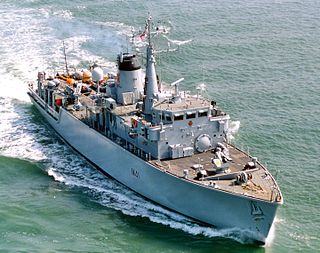
The Hunt class is a class of thirteen mine countermeasure vessels of the Royal Navy. As built, they combined the separate roles of the traditional minesweeper and that of the active minehunter in one hull, but later modifications saw the removal of mine-sweeping equipment. They have a secondary role as offshore patrol vessels.

The Sandown class is a class of fifteen minehunters built primarily for the Royal Navy by Vosper Thornycroft. The Sandown class also serve with the Royal Saudi Navy and the Estonian Navy. The first vessel was commissioned into Royal Navy service on 9 June 1989 and all the British ships are named after coastal towns and cities. They have a secondary role as offshore patrol vessels.

Standing NATO Mine Countermeasures Group 1 (SNMCMG1) is a North Atlantic Treaty Organisation (NATO) standing mine countermeasures immediate reaction force. Its role is to provide NATO with an immediate operational response capability.

The Bangor-class minesweepers were a class of warships operated by the Royal Navy (RN), Royal Canadian Navy (RCN), Imperial Japanese Navy (IJN), and Royal Indian Navy (RIN) during the Second World War.

Type 320 Lindau-class minehunters was a class of German coastal minehunters built as part of the first FRG naval program. The ships were made from non-metallic components and built by Burmester Bremen. None of these ships now remain in service with the German Navy. Several went into service with the Estonian and Lithuanian Navy, as well as the Latvian Naval Forces. Flensburg and Weilheim became museum pieces.

The Osprey class are a series of coastal minehunters designed to find, classify, and destroy moored and bottom naval mines from vital waterways.
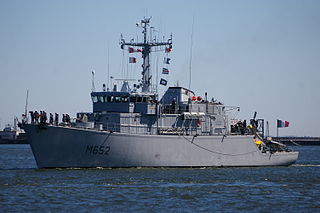
The Tripartite class is a class of minehunters developed from an agreement between the navies of Belgium, France and the Netherlands. A total of 35 ships were constructed for the three navies. The class was constructed in the 1980s–1990s in all three countries, using a mix of minehunting, electrical and propulsion systems from the three member nations. In France, where they are known as the Éridan class they are primarily used as minehunters, but have been used for minesweeping and ammunition transport in Belgium and the Netherlands, where the Tripartites are known as the Alkmaar class.

HMS Blyth is a Sandown-class minehunter formerly of the British Royal Navy. She was the second vessel to bear the name. The first being a Bangor-class minesweeper of the Second World War, pennant number J15. The vessel served in the Middle East as part of the 9th Mine Countermeasures Squadron. In 2021, the minehunter was decommissioned and following a refit, planned to be transferred to an unspecified non-European navy.
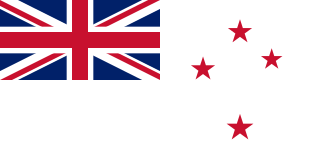
Commissioned minesweepers and danlayers of the Royal New Zealand Navy (RNZN) from its formation on 1 October 1941 to the present. The RNZN was created two years into World War II. For coherence this article covers the war years from the start, and thus includes also the New Zealand minesweepers operating from the beginning of the war.
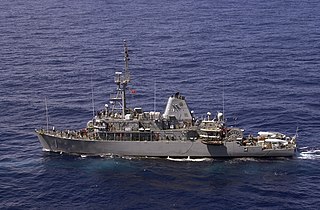
Avenger-class mine countermeasures ships are a class of 14 ships constructed for the United States Navy from 1987 to 1994, designed to clear mines from vital waterways. The ships have the hull designator MCM.

The Lerici class is a class of minehunters constructed by Intermarine SpA and owned and operated by the Italian Navy. The class incorporates two subclasses: the first four ships are referred to specifically as the first series of the Lerici class, while eight more ships produced to a slightly modified design are known as "second series Lericis" or as the Gaeta class.
Intermarine is an Italian shipbuilding company, owned by the Rodriquez Cantieri Navali Group.

The Enoshima class is a class of coastal minesweepers of the Japan Maritime Self-Defense Force.

The Hirashimaclass is a class of coastal minesweepers of the Japan Maritime Self-Defense Force.

The Sugashimaclass is a class of coastal minesweepers of the Japan Maritime Self-Defense Force.
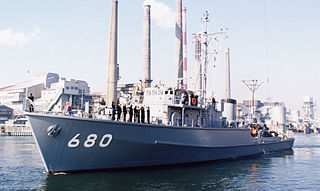
The Uwajimaclass is a class of coastal minesweepers of the Japan Maritime Self-Defense Force.